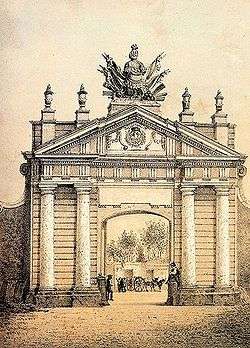Walls of Lima

The Walls of Lima were a fortification consisting mainly of walls and bastions whose purpose was to defend the city of Lima from attacks from outside. It was built between 1684 and 1687 during the government of viceroy Melchor de Navarra y Rocafull (Duke of the Palata).
The wall was located in the stroke of the current avenues Alfonso Ugarte, Paseo Colón, Grau and the left bank of Rímac River. During the municipal management of Luis Castaneda Lossio it recovered a section of the remains of the left bank of the Rímac River and are now visible part of the group known as "Parque de la Muralla", although these are probably of a Previous construction known as "Tajamar de San Francisco". The bastion Santa Lucía is a sector of the wall located on the edge of Barrios Altos and El Agustino that still stands.[1]
History
_-_AHG.jpg)


The old wall was built around the city to protect the pirate, corsairs and attacks of the enemies of the Spanish crown in the 17th century. The wall had 10 gates of entry and exit: Martinete, Maravillas, Barbones, Cocharcas, Santa Catalina, Guadalupe, Juan Simón, San Jacinto, Callao and Monserrate and the gate of la Guía en el Barrio de San Lázaro (now Rímac district).
In addition to the defensive walls, it was on the banks of the Rímac Riverel the seawall, which served to protect the city from floods of that river, which some sections can still be seen. For it has recovered part of the seawall at the back of the Church of San Francisco, near the Government Palace, which has created a public space that is it has given the name of Parque de la Muralla. In this park it can see remnants of the foundations that had the seawall, work of the Franciscans in 1610. The aforementioned park has a restaurant, a craft shop in different areas of the country, standing on the same the statue of the conqueror Francisco Pizarro, which for many years was housed in the now "Plaza Perú", located next to the Government Palace; also is a museum exhibiting archaeological pieces found in the area.
As part of programs of urban expansion and construction of new avenues it proceeded to its demolition in 1868 during the government of José Balta. It never served for which it was built, to the point that Raúl Porras Barrenechea mentioned that "died virgin of gunpowder."
Current status
The Parque de La Muralla built on the seawall of the Rímac, is a valuable public space recovered for the city of Lima as part of the recovery of the banks of the Rímac River. The wall stretched from the area today recovered to Monserrate, including the current Grau Avenue. The works on the construction of an expressway in that avenue it uncovered some remains.
In the Barrios Altos are remains of the walls in good condition, by the area of the Plazuela del Cercado and the camal de Conchucos which is what was the bastion of Santa Lucía, one of the surveillance points of the wall, now runs a sports complex. It should be remembered that in this area there are 150 meters from The Wall in excellent condition that the municipality could also regain.
When in 1964 was ordained the demolition of solars of street Rastro de La Penitencia, it was discovered that colonial room hovels still served as rooms for very needy people.
The Wall was not a paragon of beauty. Except the portals of Maravillas (1807) in the Barrios Altos and El Callao, the other gates (10), to tell the painter Juan Manuel Ugarte, had no greater artistic appeal. What remains of the Wall in Santa Lucía, if it is in good condition, and that is why the religious institution that protects now it not destroyed in 2013. It is one of the most important tourist attractions besides also houses the expociencia among others.
See also
Notes
Bibliography
- Hanke, Lewis (1980). Los virreyes españoles durante la casa de Austria (in Spanish). Volume VII. Madrid: Ediciones Atlas.
- Basadre, Jorge (1983). Historia de la República del Perú (in Spanish). Volume V (7th ed.). Lima: Editorial Universitaria.
